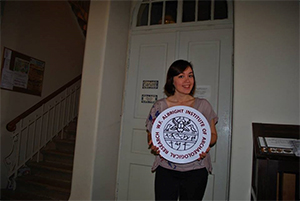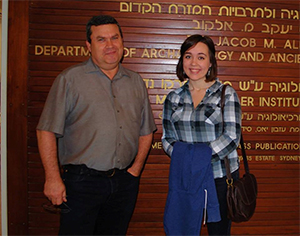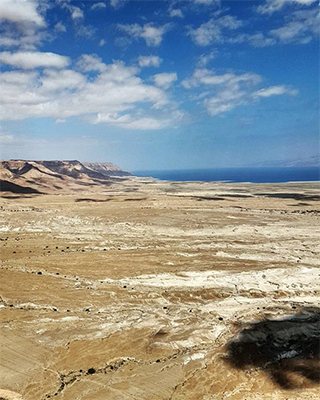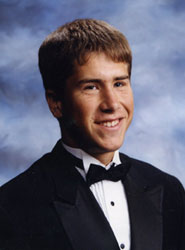Judaic Studies Minor, Taylor Thomas, visits Albright Institute in Israel
 This past March, I was fortunate enough to travel to Israel for the week of spring break, funded by the Program of Judaic Studies' generous student scholarships and the Chancellor's Honors Program's Ready for the World Fund. The plan was to meet with Dr. Erin Darby, my academic advisor in the Departments of Religious Studies and Judaic Studies at the Albright Institute for Archaeological Research in Jerusalem in order to further my research for my senior honors thesis. We were also planning to travel around the country, visit various archaeological sites, and experience Israeli culture. After months of reading up on sites, studying Hebrew well enough to read a few street signs, and perusing at least a dozen "What to Pack for Israel in Mid-March" internet articles, I was ready to head to the airport.
This past March, I was fortunate enough to travel to Israel for the week of spring break, funded by the Program of Judaic Studies' generous student scholarships and the Chancellor's Honors Program's Ready for the World Fund. The plan was to meet with Dr. Erin Darby, my academic advisor in the Departments of Religious Studies and Judaic Studies at the Albright Institute for Archaeological Research in Jerusalem in order to further my research for my senior honors thesis. We were also planning to travel around the country, visit various archaeological sites, and experience Israeli culture. After months of reading up on sites, studying Hebrew well enough to read a few street signs, and perusing at least a dozen "What to Pack for Israel in Mid-March" internet articles, I was ready to head to the airport.
Unfortunately, life had different plans for me. I missed my first flight from the international airport in Nashville and ended up having to spend the day unexpectedly in London's Heathrow Airport. When I finally arrived in Ben Gurion Airport in Tel Aviv, it was early in the morning the day after I was originally scheduled to arrive – without any luggage, which was placed on my original flight. Needless to say, what I needed most in that moment was caffeine, so with the purchase of an Israeli iced coffee (which I have come to crave every day since returning to the United States), I set off from Tel Aviv towards Jerusalem with Robert Darby, slightly upset that it was too dark outside for me to fully appreciate my first look at the country. Regardless of the dim lighting and my exhausted state, driving down towards Jerusalem and seeing the unique outline of the city against the dark sky was enough to cause a sensation of butterflies in my stomach.
The next day was spent adjusting to the new time zone and getting to know the Albright Institute. I visited the YMCA of Jerusalem, which predates the official creation of the State of Israel. It's an incredibly beautiful building with grand architecture, vibrant foliage, and an interesting past. Carved high in the magnificent stone are inscriptions in both Hebrew and Arabic, meant to symbolize a common place where Jews and Palestinians could live alongside one another. This is evident in the way the institution is run. The preschool, where the Darbys' daughter Maddie attends, is taught entirely in Hebrew and Arabic by Israeli and Palestinian teachers to students of various backgrounds. After picking up Maddie, we went out for Palestinian pizza.
 The next day started on a high note – my luggage had been found. After an awkward phone conversation stemming from my complete inability to communicate in Hebrew, we retrieved my luggage so that I could – finally! – change into some clean clothes and actually go out and do something for the day. We drove out to Lachish with a picnic of falafel and hummus and fresh vegetables. It was on this day that I got my first real glimpses of the landscape of Israel. It was chilly outside, and very windy. I was surprised by how green the Shephelah was – and how much worse my allergies got! I was hoping that by leaving Eastern Tennessee I would have left them behind as well. We sat at a picnic table at the base of the tel and ate our lunch, and then we hiked up the side of the hill where the Assyrian siege ramp was in the eighth century BCE. Most of the site was closed for excavations so there was not much to see as far as ancient structures go, but the flowers on site were beautiful, it was a nice, cool day, and the view overlooking fields and trees from the top of the tel was spectacular.
The next day started on a high note – my luggage had been found. After an awkward phone conversation stemming from my complete inability to communicate in Hebrew, we retrieved my luggage so that I could – finally! – change into some clean clothes and actually go out and do something for the day. We drove out to Lachish with a picnic of falafel and hummus and fresh vegetables. It was on this day that I got my first real glimpses of the landscape of Israel. It was chilly outside, and very windy. I was surprised by how green the Shephelah was – and how much worse my allergies got! I was hoping that by leaving Eastern Tennessee I would have left them behind as well. We sat at a picnic table at the base of the tel and ate our lunch, and then we hiked up the side of the hill where the Assyrian siege ramp was in the eighth century BCE. Most of the site was closed for excavations so there was not much to see as far as ancient structures go, but the flowers on site were beautiful, it was a nice, cool day, and the view overlooking fields and trees from the top of the tel was spectacular.
That night, I had my first dinner at the Albright Institute with the fellows who were working there. Walking up to the dining room I was incredibly anxious. I was to enter that intimidating dining room alone, but my fears proved to be unfounded. First of all, the food was some of the best I've ever had. Secondly, it was inspiring to eat in the same room with scholars who were doing exactly what I want to do with my life. Talking about research topics, methodologies, and all of the little quirks that come with the profession and planning a trip to visit Tel Aviv University later in the week made me so grateful to have been given the opportunity to study there and even more excited to some day be a part of the scholarly and archaeological community.
Finally getting over my jet lag, we realized the next day that I had not even had the chance to explore Jerusalem yet. We drove around for a while and I was able to to see the Old City from above (because the university did not allow me to enter the Old City) and spent the rest of the day meeting people in the shops and restaurants. I had plenty of bagels and lox, of course! I wandered the streets looking for tchotchkes to bring home to my parents who have never been to Israel before. The fellows at the Albright are international scholars, so this time in Jerusalem was my first chance to really interact with Israelis, apart from the brief interactions I had had with airport officials. I spent the remainder of the day studying in the Albright Institute's research library, which, being one of the main driving factors for my travel, houses many excavation reports and publications that otherwise would have been hard for me to get my hands on. My senior honors thesis, which is on the bearings of second millennium BCE Ugaritic literature on first millennium BCE Israelite religion, greatly benefitted from this experience, as I was able to start a catalog of relevant data as a reference for when I arrived back in the states. Utilizing this resource expanded my thesis in a way that I didn't think it could, incorporating more archaeological data and scholarship that more broadly situates my thesis in space and time.
 The next day, Dr. Darby and I went on a field trip with the Albright fellows to Tel Aviv University. This was quite exciting as I got to meet with renowned Israeli archaeologist Oded Lipschits, who informed me about all of the graduate programs the Department of Archeology and Ancient Near Eastern Cultures offers. We toured all of the different archaeological research labs that the institute houses. This was exciting because this is exactly the type of program I would like to apply to someday (especially the programs offered specifically for international students). They have more archaeology-specific labs than any other university I am aware of, and they are located right in the area that I am interested in researching.
The next day, Dr. Darby and I went on a field trip with the Albright fellows to Tel Aviv University. This was quite exciting as I got to meet with renowned Israeli archaeologist Oded Lipschits, who informed me about all of the graduate programs the Department of Archeology and Ancient Near Eastern Cultures offers. We toured all of the different archaeological research labs that the institute houses. This was exciting because this is exactly the type of program I would like to apply to someday (especially the programs offered specifically for international students). They have more archaeology-specific labs than any other university I am aware of, and they are located right in the area that I am interested in researching.
After having lunch at the university, we headed over to the Eretz Israel museum and toured many exhibits, including some that were directly in line with my research interests, such as the exhibit on the early monarchial city of Rehov, and some that helped me gain a new perspective on Israeli culture, such as the Israeli Collective Portrait special installation, which contained a great number of portraits of Israeli citizens to showcase the diversity of Israeli culture. One exhibit on the historical memory of Bar Kokhba, was particularly interesting to me because it placed a historical figure that I have read much about in perspective for the centuries since. It showed how historical occurrences and figures are reimagined and incorporated into modern cultural identities, narratives, and propaganda to create new significance and meaning in order to invoke inspiration and feelings of connection to them. We also toured Tel Qasile, which is right on the museum's land and included getting to see the remains of the Bronze Age temple.
 On the ride home, we became lost, which was all right with me because I got to see more of the country. I am still struck with how remarkable the landscape is. I have seen a thousand pictures and read thousands of words about the Judean Hill Country, its green grass and rocky terrain, and the dilemmas it posed for agriculture, but none of it could have prepared me for how it actually looks. It seems utterly impossible to cultivate those hills for farming, and yet it was done. It really was overwhelming, and I wish I had the words to describe it now, but it really is a sight that must be seen to be fully appreciated.
On the ride home, we became lost, which was all right with me because I got to see more of the country. I am still struck with how remarkable the landscape is. I have seen a thousand pictures and read thousands of words about the Judean Hill Country, its green grass and rocky terrain, and the dilemmas it posed for agriculture, but none of it could have prepared me for how it actually looks. It seems utterly impossible to cultivate those hills for farming, and yet it was done. It really was overwhelming, and I wish I had the words to describe it now, but it really is a sight that must be seen to be fully appreciated.
That night, UT Judaic Studies alumna Lily Dropkin, who is participating in a cultural resource management internship in Acre, stopped in to spend the weekend with us. The next day was my favorite day of the trip, because I finally returned to the desert, which I had fallen in love with when I worked in Jordan during the summer of 2015. We drove down to the Dead Sea and hiked up Herod's desert fortress Masada, which had incredible views and helped really put some of my readings in perspective through just experiencing the scope of the place as well as discussion with Dr. Darby. After visiting Masada, we drove down to Qumran hoping to tour it, but unfortunately, we had forgotten that they closed early because of Shabbat, so we instead headed back to the Albright for the night and decided to try Qumran again the next day.
When we finally got to Qumran, we toured the site, and I really gained a new appreciation for all of the texts that are possibly linked to the site, which discuss punishments linked to the desert and the heat, because it was incredibly humid and hot right there on the Dead Sea. Robert Darby and I hiked up behind the site because he had remembered being able to crawl through the aqueduct system when he had visited eight years ago. Unfortunately, we were unable to find the subterranean entrance, but Dr. Darby and I were determined to continue to look, so she and I continued to hike through the wadi and up the rocky terrain to try and find the exit to the aqueduct while Robert, Lily, and Maddie went back to the site. As we were nearing the top with its incredible views of the Dead Sea, we began to see smoke coming from the top of the mountain. No sooner did Dr. Darby say the words, "Is that fire?" than a fire shot up out of the mountain. As we debated on whether or not to see if someone needed help, we saw Robert way off in the distance waving his arms and ushering us back. We quickly descended the mountain and finally returned to the site, where we learned that the Israeli military was apparently running some tests in the mountains which was why the area was closed.
After leaving Qumran, we drove back from the desert and visited my last site: Tel Megiddo. Once again, the tel's hill-like structure allowed for some fantastic views of the country, and it was a beautiful warm and windy day. That night, we walked through Jerusalem to get some falafel, and I just remember thinking how I wished I could have had more time there. A week is such a short amount of time to see so many things! Early the next morning, Robert drove me back to the airport in Tel Aviv, and, luckily this time, I didn't miss my flight. As the plane took off and I looked out the window down at the beautiful country below, I let go of the regret I'd felt the previous night about the short length of my trip, because I knew that before long life would return me to Israel. As I look forward to a life full of archaeology, scholarship, and travel, I am incredibly thankful for the opportunity that UT and the Program of Judaic Studies provided me to jumpstart my career.Rich Adams
 Rich Adams is a senior in Judaic Studies with a Spanish minor at the University of Tennessee. He is 25 years old and lives on Sutherland Avenue with his wife of three years, Natali. He speaks three languages fluently and is working on his fourth, Hebrew. Rich is applying for admission in the Middle-Eastern Studies program at the University of Utah where he plans on an emphasis in the Hebrew language, history and literature. He enjoys swimming, movies and the mountains, although there is not much time for these with his course-load of 21 hours and active service in his church, The Church of Jesus Christ of Latter-day Saints.
Rich Adams is a senior in Judaic Studies with a Spanish minor at the University of Tennessee. He is 25 years old and lives on Sutherland Avenue with his wife of three years, Natali. He speaks three languages fluently and is working on his fourth, Hebrew. Rich is applying for admission in the Middle-Eastern Studies program at the University of Utah where he plans on an emphasis in the Hebrew language, history and literature. He enjoys swimming, movies and the mountains, although there is not much time for these with his course-load of 21 hours and active service in his church, The Church of Jesus Christ of Latter-day Saints.
Rich graduated with a major in Judaic Studies in May of 2010. Congratulations!